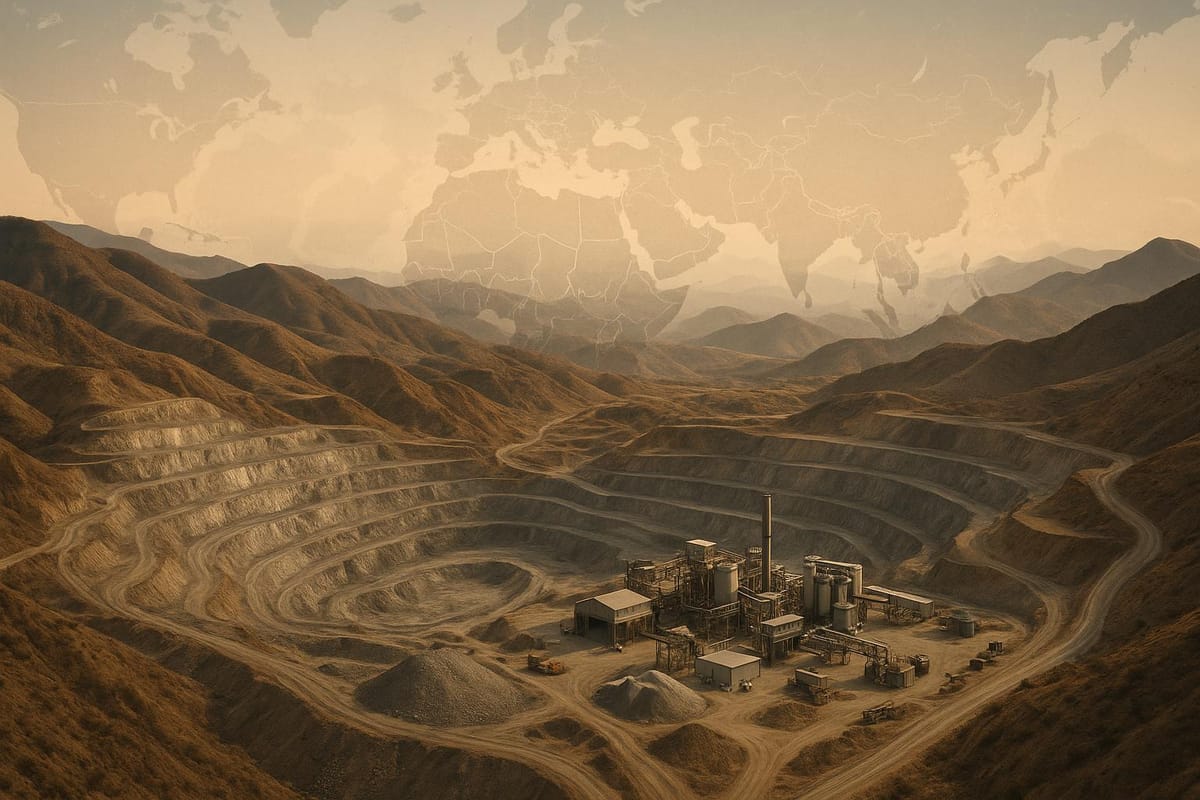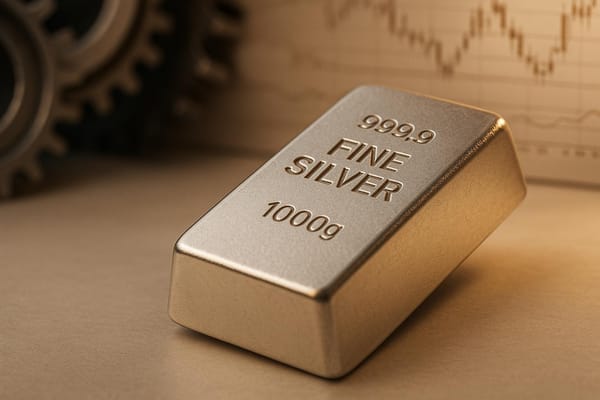How Geopolitical Tensions Affect Silver Mining Stocks
Geopolitical tensions significantly influence silver mining stocks by affecting production, investor demand, and currency fluctuations, creating both risks and opportunities.

When geopolitical tensions rise, silver mining stocks often experience sharp price changes. Why? Silver serves a dual purpose: it's a key industrial metal for electronics and solar panels, but it's also a safe-haven asset during crises. This creates a unique dynamic where global events can disrupt production while simultaneously boosting demand.
Key takeaways:
- Production Risks: Political instability in major silver-producing regions (e.g., Latin America) can lead to mine closures, labor shortages, and supply chain disruptions.
- Investor Demand: During uncertainty, silver's safe-haven status attracts investors, often driving up prices and benefiting mining stocks.
- Currency Impact: A weaker U.S. dollar during crises can increase silver prices, boosting revenues for mining companies.
To navigate these risks, focus on diversified investments across regions, monitor geopolitical developments, and prioritize companies with strong financials and operations in stable countries.
Geopolitical Risks in Silver Mining
Understanding Geopolitical Tensions in Silver Mining
Geopolitical tensions in silver mining arise from factors like international sanctions, trade disputes, and regional conflicts. These issues can disrupt supply chains, slow down production, and create volatility in global markets. Such challenges are particularly impactful in regions that play a key role in the global silver supply chain.
Key Silver-Producing Regions and Associated Risks
Several major silver-producing countries face risks tied to political instability and international conflicts. Sanctions and trade disagreements in these areas can disrupt mining operations and make it harder to maintain consistent production levels. For investors, keeping an eye on how geopolitical shifts influence mining activities across different regions is essential.
The Dual Nature of Silver and Its Sensitivity to Geopolitical Events
Silver serves a unique dual purpose - it’s both a critical industrial material and a safe-haven asset. This duality makes it especially sensitive to geopolitical disruptions. Production slowdowns can ripple through industries that rely on silver, while global crises often drive up investor demand, further affecting the market.
Dave Erfle – Geopolitics & Trade Wars Causing Gold & Silver Stocks To Pop While General Markets Drop
How Geopolitical Events Impact Silver Mining Stock Prices
Geopolitical events have a direct impact on silver mining stock prices through disruptions in supply, shifts in demand for safe-haven assets, and currency fluctuations. By understanding these factors, investors can better predict market changes and make smarter decisions during times of global uncertainty.
Supply Chain Disruptions and Silver Production
Geopolitical instability often leads to disruptions in silver production and distribution, which can significantly affect stock values. For example, mine closures halt production and revenue streams almost immediately. Similarly, sanctions or transportation issues can delay shipments and create inventory backlogs, leading to an artificial scarcity that drives up silver prices while complicating company operations.
In regions facing political unrest, transportation networks are often disrupted, making it harder for mining companies to deliver their products to international markets. This can result in inventory piling up and a strain on cash flow, putting additional pressure on earnings.
Labor shortages also play a role. When instability forces workers to leave or international staff to evacuate, mining operations lose the specialized expertise they rely on. This can reduce production capacity for extended periods, further impacting stock performance.
Investor Flight to Safety and Demand for Precious Metals
During geopolitical turmoil, silver often becomes a safe-haven asset, attracting investors and supporting its price. This increased demand benefits silver mining stocks in two key ways: higher silver prices improve revenue per ounce sold, and heightened investor interest in the sector can push stock valuations above their usual levels.
Precious metals, including silver, are a popular choice for portfolio diversification during crises. Both individual investors and large funds tend to allocate more resources to silver-related investments, creating sustained buying pressure. Even when mining operations face challenges, this demand can help stabilize or even boost stock prices.
Currency Fluctuations and Monetary Policy Impacts
Geopolitical events often cause major shifts in currency markets, which directly influence silver mining stock valuations. For instance, when the U.S. dollar weakens during international crises, silver prices typically rise since the metal is priced globally in dollars. This dynamic can significantly increase revenues for mining companies, particularly those operating in countries with strengthening local currencies.
Central bank actions also play a role. Policies such as interest rate cuts can make silver more appealing compared to interest-bearing assets, further driving demand and lifting mining stock prices.
Exchange rate volatility affects mining companies in different ways, depending on where they operate. Companies with costs in weaker local currencies but revenues in stronger ones may see their profit margins grow. On the other hand, those with the opposite setup could face financial pressure. These currency dynamics often lead to varied performance among mining stocks during the same geopolitical event.
Investment Strategies During Geopolitical Uncertainty
Investors looking to navigate geopolitical volatility can take steps to safeguard their portfolios while still benefiting from silver's potential growth. A well-thought-out strategy can help balance political risks with opportunities in the silver market. Below, we explore ways to diversify investments, manage geographic risks, and evaluate company resilience during uncertain times.
Diversifying Silver Investment Exposure
Spreading silver investments across different asset types can help cushion the impact of geopolitical events. Instead of focusing solely on individual mining stocks, consider a broader approach that incorporates various forms of silver investments.
- Physical silver: Owning silver bars or coins provides direct protection during political crises. Unlike mining stocks, physical silver isn't tied to a company's operational challenges or regional political risks. It acts as a tangible asset that retains value, even during periods of instability.
- Silver ETFs: These funds offer exposure to silver prices without the company-specific risks tied to mining operations. They allow investors to benefit from silver's price movements without being overly reliant on individual firms.
- Mining stocks: Diversifying across mining companies with operations in different regions helps reduce exposure to risks tied to a single country or area. This approach allows investors to enjoy the sector's growth potential while spreading out geographic vulnerabilities.
Managing Geographic and Political Risks
Geographic diversification is essential when selecting mining stocks. Companies with operations spanning multiple regions are generally less vulnerable to localized political disruptions than those heavily concentrated in a single, high-risk area.
- Focus on stability: Prioritize mining companies operating in countries known for political stability, clear legal systems, and well-established mining regulations. Regions such as Canada, Australia, and the United States often provide a more predictable environment compared to areas with frequent political unrest.
- Examine regulatory environments: Look into the legal and tax frameworks of the countries where your chosen companies operate. Transparent mining laws, consistent tax policies, and strong property rights create a more secure investment landscape. Avoid companies overly reliant on regions with histories of abrupt regulatory changes or political instability.
Risk Assessment Methods for Mining Stocks
During times of geopolitical uncertainty, evaluating the financial health and operational resilience of mining companies becomes even more critical. Firms with strong financials and adaptable operations are better equipped to handle disruptions.
- Financial strength: Look for companies with solid balance sheets, low debt levels, and ample cash reserves. These factors help firms weather temporary production halts or market fluctuations.
- Operational flexibility: Companies that can adjust production, reroute shipments, or pause operations in high-risk areas demonstrate greater resilience. Assess management teams for their ability to navigate previous crises successfully.
- Political risk insurance: Some mining companies mitigate risks by purchasing insurance that covers losses due to government actions or political violence. This added layer of protection can enhance a company's ability to manage geopolitical challenges.
Case Studies: Geopolitical Events and Silver Mining Stock Performance
Looking at real-world examples, it's clear how geopolitical tensions can sway the performance of silver mining stocks. Let’s dive into some recent and historical events to see these dynamics in action.
Recent Examples: Russia-Ukraine Conflict and Middle East Tensions
When the Russia-Ukraine conflict erupted in early 2022, markets reacted swiftly. Investors turned to silver as a safe-haven asset, and mining companies operating in regions far from the conflict saw better performance compared to those directly impacted. This underscores the importance of geographic diversification in mitigating risks.
A similar trend emerged during the heightened tensions in the Middle East in late 2023. Regional instability once again influenced the silver market, echoing patterns seen in past crises. These examples highlight how geopolitical events can ripple through the market, affecting stock performance.
Historical Examples: Patterns from Past Geopolitical Crises
History shows that geopolitical crises often leave a mark on silver mining stocks. Events like the 2020 pandemic and the 2008 financial crisis caused market-wide panic, but companies with diverse operations and strong financial health tended to recover more effectively.
These past events reveal recurring themes: initial panic usually triggers widespread selling, geographic diversification helps cushion regional risks, and companies with solid fundamentals tend to navigate crises more successfully. These insights align with earlier advice on diversification and thorough risk assessment for silver mining investments.
Tools for Monitoring and Managing Geopolitical Risks
Keeping up with global developments is key to staying ahead of geopolitical risks. By leveraging the right tools and resources, you can monitor trends, assess risks, and respond to geopolitical shifts before they affect your investments in silver markets.
Resources for Tracking Geopolitical and Market Trends
To understand how global events may influence silver markets, you need access to reliable information and analysis. Here are some essential resources:
- News and Analysis Platforms: Outlets like Reuters and Bloomberg provide up-to-the-minute coverage of international events, while specialized publications such as Foreign Affairs and Stratfor dive deeper into the geopolitical landscape. These sources not only report on what’s happening but also explain why it matters for silver markets.
- Government and Institutional Reports: Authoritative insights into global risks can be found in resources like the U.S. State Department’s travel advisories and country reports, which shed light on political stability in major silver-producing regions. Additionally, the World Bank’s political risk assessments and the International Monetary Fund’s economic outlooks offer a broader view of how geopolitical tensions may affect the global economy.
- Industry-Specific Intelligence: For those investing in silver mining, niche publications such as Mining Journal and Metal Bulletin are invaluable. They track developments in the precious metals market, while platforms like Gold and Silver.net provide detailed analysis on how geopolitical events impact silver investments, including mining stock performance during turbulent times.
- Financial Data Terminals: Tools from major providers offer specialized market data and news feeds tailored to the mining and precious metals sectors. Many brokers also supply research reports on geopolitical risks specific to mining companies, offering a focused lens for investors.
Risk Assessment Tools for Better Decision-Making
Beyond tracking news, having the right tools to assess and manage risks is crucial for making informed decisions about your investments.
- News Alert Systems and Economic Calendars: These tools ensure you’re always in the loop without needing to monitor multiple sources constantly. Set up Google Alerts for terms like "silver mining" paired with key countries where your investments are located. Economic calendars help you track critical events like elections, policy announcements, and international summits that could influence silver markets.
- Portfolio Analysis Tools: These tools allow you to evaluate your exposure to geographic and political risks. By visualizing your portfolio’s geographic distribution, you can identify areas of concentration and strategize diversification efforts to mitigate potential vulnerabilities.
- Correlation Analysis: This technique helps you understand how your silver mining stocks have historically reacted to geopolitical events. Comparing past stock performance during similar crises can highlight which companies tend to remain more stable during turbulent times, giving you a clearer picture of potential resilience.
No single tool can provide all the answers, but combining diverse resources with systematic risk assessments offers a more comprehensive view. A balanced approach allows you to uncover emerging risks and opportunities, helping you stay ahead in the ever-changing landscape of silver mining investments.
Conclusion: Key Points for Silver Mining Stock Investors
Understanding how geopolitical tensions influence silver mining stocks is essential for spotting opportunities and managing risks effectively.
One smart approach is to diversify your portfolio across multiple regions. Relying too heavily on mining companies from a single country can leave you vulnerable to localized risks, such as political instability or regulatory changes.
Silver plays a unique dual role - it’s both an industrial metal and a safe-haven asset. This duality often fuels market volatility, especially during global crises. For instance, supply chain disruptions in major producers like Mexico, Peru, or China can push prices higher. At the same time, heightened investor demand for precious metals during uncertain times can magnify price swings, directly affecting the value of mining stocks.
Stay proactive by using specialized news alerts and portfolio tools. Setting up alerts and regularly reviewing your exposure to specific regions can help you stay ahead of sudden geopolitical changes. These tools are invaluable for managing risks and seizing opportunities.
Remember, historical patterns don’t always repeat. It’s crucial to remain flexible and focus on companies with strong fundamentals - those with resilient operations, solid balance sheets, and diversified projects in stable regions tend to navigate geopolitical challenges more effectively.
Investing in silver mining stocks requires thorough research, sharp risk management, and disciplined decision-making. By staying informed and adopting a diversified strategy, you can better position yourself to navigate the complexities of global tensions while taking advantage of potential opportunities in the market.
FAQs
What should investors look for in silver mining stocks to minimize risks from geopolitical tensions?
When looking into silver mining stocks, it’s essential to weigh a few key factors that can help reduce risks tied to geopolitical tensions. For starters, companies operating in politically stable regions tend to face fewer disruptions, so geographical diversification becomes a smart strategy to consider.
Another important element is a company’s commitment to environmental, social, and governance (ESG) practices. Firms with strong ESG policies often gain more institutional backing and show greater stability over time - something investors value in the long run.
Production diversification also plays a big role. Mining companies that extract multiple metals - like gold or platinum - can balance out risks from fluctuations in the silver market. Lastly, take a close look at the company's supply chain. This includes the location of its mines and how vulnerable they might be to interruptions in key mining areas. These considerations can help pinpoint stocks that are better equipped to handle geopolitical uncertainty.
How can investors manage risks from geopolitical events in silver-mining regions?
Investors looking to navigate the risks tied to geopolitical issues in silver-mining regions can take several practical steps. One effective approach is diversifying investments across a range of mining companies and geographic areas. This reduces dependence on any single region that might face political turmoil or instability.
Keeping a close eye on global events and regularly conducting risk assessments is another smart move. This proactive monitoring can help investors anticipate disruptions before they escalate.
It's also wise to focus on mining companies known for their robust supply chain management and contingency planning. These companies are often better equipped to handle unexpected challenges. To further balance potential risks, consider allocating part of your portfolio to other precious metals, like gold, which can act as a stabilizing factor when silver markets face uncertainty.
Ultimately, staying informed about geopolitical developments is key to making timely, well-thought-out investment decisions.
How do geopolitical crises and currency changes impact silver mining companies' profitability?
Geopolitical crises often stir up currency fluctuations, which can directly affect the profits of silver mining companies. In uncertain times, silver is frequently viewed as a safe-haven asset, which can drive up both demand and prices. But the influence of currency shifts isn’t always straightforward.
Take the U.S. dollar, for instance. When the dollar strengthens, silver becomes pricier for international buyers, potentially dampening demand and cutting into mining companies' revenues. Conversely, a weaker dollar tends to make silver more attractive on the global market, pushing prices higher and boosting mining firms' profitability. These shifting dynamics underscore the need to keep a close eye on geopolitical developments and currency movements when assessing silver mining stocks.



